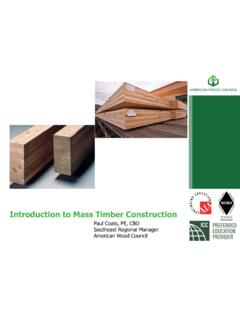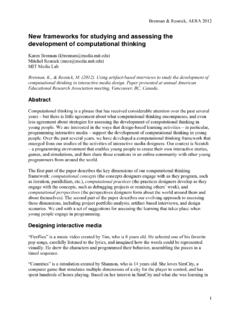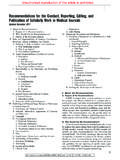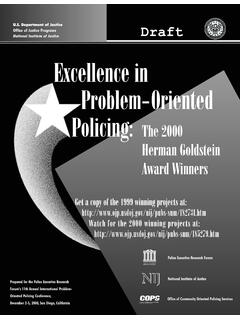Transcription of Heat Recovery Ventilation Guide for Houses
1 Heat Recovery Ventilation Guide for Houses Heat Recovery Ventilation Guide for Housesi Purpose of the Guide This Guide will assist designers, developers, builders, renovators and owners gain a better understanding of heat Recovery ventilators (HRVs) and energy Recovery ventilators (ERVs) and how they can support healthy indoor living environments in single family, semi detached and row housing (herein referred to as Houses ), including: Why ventilating Houses is important; Existing residential Ventilation system code requirements; How HRVs and ERVs work; The importance of early planning to facilitate HRV/ERV installation and to ensure efficient and effective operation; System design considerations for both new Houses and existing house retrofits; and Important balancing, commissioning, maintenance and operation considerations.
2 This publication is not intended to replace the training materials developed for residential mechanical Ventilation system design and installation contractors. Heat Recovery Ventilation Guide for Housesii Acknowledgments This Guide would not have been possible without the funding and technical expertise provided by BC Hydro Power Smart, the City of vancouver , Natural Resources Canada CanmetENERGY, and Canada Mortgage and Housing Corporation (CMHC). The Homeowner Protection Office (HPO) would like to thank the members of the Technical Steering Committee for their time and contributions. Acknowledgment is also extended to RDH Building Engineering Ltd. who was responsible for the development of the Guide .
3 Disclaimer This Guide reflects an overview of current good practice in the design and installation of residential heat Recovery Ventilation systems; however, it is not intended to replace professional design and installation guidelines. When information presented in this Guide is incorporated into a specific building project, it must respond to the unique conditions and design parameters of that building. Use of the Guide does not relieve designers and installers of their responsibility to comply with local building codes, standards, and by laws with respect to the design and installation of a residential Ventilation system. The greatest care has been taken to confirm the accuracy of the content.
4 However, the authors, funders, publisher, members of the project Steering Committee and other contributors assume no liability for any damage, injury, loss or expense that may be incurred or suffered as a result of the use of this publication, including products, building techniques or practices. The views expressed do not necessarily represent those of any individual contributor. Main entry under title: Heat Recovery Ventilation Guide for Houses ISBN 978 0 7726 6883 7 Copyright 2015, all rights reserved. Homeowner Protection Office Branch of BC Housing 1701 4555 Kingsway Burnaby, British Columbia, V5H 4V8 Canada Heat Recovery Ventilation Guide for Housesiii Table of Contents 1.
5 Introduction 1 2. Residential Ventilation Practices 4 3. Heat and Energy Recovery Ventilation 8 4. System design and Installation 15 5. HRV Retrofits for Existing Houses 29 6. Commissioning, Balancing and Troubleshooting 37 7. Operation and Maintenance Information for Homeowners 42 Appendices 45 Appendix A Sample HRV/ERV Product Data Sheet 45 Appendix B Example Ductwork Layout and Sizing 46 Appendix C References 50 Appendix D Glossary 51 Chapter 1 Introduction 1 1. Introduction Ventilation is the process of supplying air to and/or removing air from a space for the purpose of controlling air contaminant levels, humidity, or temperature.
6 It is an important contributor to the health and comfort of an indoor environment. Specifically, Ventilation serves two primary purposes: 1. To provide oxygen for occupants to breathe. 2. To dilute or remove contaminants. These contaminants can include any of the following: a. Moisture generated by people, pets, and plants, and by activities such as cooking and showering. b. Contaminants and odours generated by interior sources including people, plants, cooking, household cleaners, and off gassing of interior finishes and furnishings. c. Contaminants from exterior air, including dust, particulates, allergens, and mould. Poor indoor air quality has reported impacts on human health, particularly the young, elderly, and those with sensitivities.
7 Impacts can include increased asthma, headaches, and fatigue. Health Canada publishes Residential Indoor Air Quality Guidelines, which advise on recommended exposure limits for a range of indoor pollutants, including benzene, carbon monoxide, fine particulate matter, formaldehyde, mould, naphthalene, nitrogen dioxide, ozone, and toluene1 all of which can be found in homes. While source control is an essential first step toward limiting exposure to indoor pollutants2, adequate Ventilation (paired with filtration) is a critical means of establishing and maintaining indoor air quality. There are two traditional approaches to providing Ventilation to a space: 1. Natural (passive) Ventilation where airflow is driven by natural pressure differentials through open windows, doors, grilles, and other planned penetrations.
8 2. Mechanical Ventilation where airflow is planned and controlled using fans and associated ductwork, grilles, diffusers and vents. Natural Ventilation can cause drafts, comfort problems, and higher space heating and cooling energy consumption and costs. Additionally, natural Ventilation is unpredictable and not always available when and where needed. As housing has become better insulated and more airtight in an effort to conserve energy and reduce utility bills, mechanical Ventilation has become the preferred Ventilation strategy. Mechanical Ventilation offers a more efficient, predictable and secure mannner of Ventilation in comparison to open windows. Research has demonstrated that it is typically more cost effective to build housing to be more airtight and provide mechanical Ventilation than it is to build leaky Houses and rely on natural Ventilation .
9 For this reason, build tight ventilate right has become one of the mottos of the energy efficient home building movement. 1 semt/air/in/res in/index 2 Sources of air contaminants and moisture can be addressed in three ways: Source Removal: For example, storing contaminants and pollutants outside the living space (such as cleaning products or paints), and using appropriate filters to remove contaminants from the incoming air. Substitution: For example, selecting low emitting interior finishes and furniture. Source Containment: For example, storing contaminants and pollutants in sealed containers. Heat Recovery Ventilation Guide for Houses2 Objectives of Mechanical Ventilation To be effective, mechanical Ventilation systems must be able to: 1.
10 Exchange indoor air with outdoor air; 2. Distribute Ventilation air to most rooms of the house and exhaust air from kitchens, bathrooms and laundry rooms; 3. Circulate Ventilation air within the rooms; and 4. Treat the Ventilation air so that it is acceptable to the occupants. Exchange To exchange indoor air with outdoor air with any effectiveness and reliability, a motorized fan is needed. An exhaust fan (such as a bathroom fan, range hood, or cooktop fan) can be used to push air out of the house and, in so doing, draw air back into the house to replace that which was exhausted. Alternatively, a supply air fan could be used to drive air exchange, but a supply only approach can pressurize the house and drive moisture laden air into the building envelope where it can lead to the deterioration of structural elements and finishes and potentially to mould growth.




